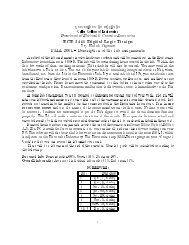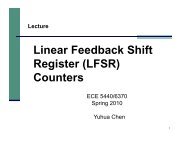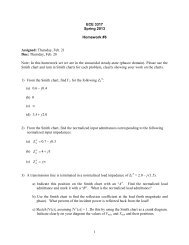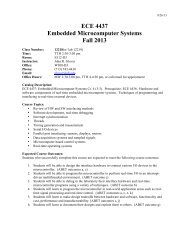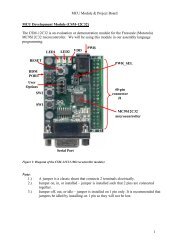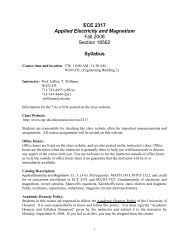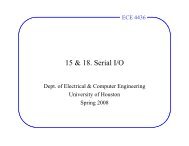Verilog for Digital Design
Verilog for Digital Design
Verilog for Digital Design
Create successful ePaper yourself
Turn your PDF publications into a flip-book with our unique Google optimized e-Paper software.
<strong>Verilog</strong> <strong>for</strong><br />
<strong>Digital</strong> <strong>Design</strong><br />
Chapter 2:<br />
Combinational Logic <strong>Design</strong><br />
<strong>Verilog</strong> <strong>for</strong> <strong>Digital</strong> <strong>Design</strong><br />
Copyright © 2007<br />
Frank Vahid and Roman Lysecky<br />
1
AND/OR/NOT Gates<br />
<strong>Verilog</strong> <strong>for</strong> <strong>Digital</strong> <strong>Design</strong><br />
Copyright © 2007<br />
Frank Vahid and Roman Lysecky<br />
2
AND/OR/NOT Gates<br />
<strong>Verilog</strong> Modules and Ports<br />
X<br />
Y<br />
F<br />
X<br />
Y<br />
F X F<br />
module And2(X, Y, F);<br />
input X, Y;<br />
output F;<br />
...<br />
module Or2(X, Y, F);<br />
input X, Y;<br />
output F;<br />
...<br />
module Inv(X, F);<br />
input X;<br />
output F;<br />
...<br />
• module – Declares a new type of component<br />
– Named “And2" in first example above<br />
– Includes list of ports (module's inputs and outputs)<br />
• input – List indicating which ports are inputs<br />
• output – List indicating which ports are outputs<br />
• Each port is a bit – can have value of 0, 1, or x (unknown value)<br />
• Note: <strong>Verilog</strong> already has built-in primitives <strong>for</strong> logic gates, but instructive to build them<br />
<strong>Verilog</strong> <strong>for</strong> <strong>Digital</strong> <strong>Design</strong><br />
Copyright © 2007<br />
Frank Vahid and Roman Lysecky<br />
vldd_ch2_And2.v vldd_ch2_Or2.v<br />
vldd_ch2_Inv.v<br />
3
X<br />
Y<br />
F<br />
AND/OR/NOT Gates<br />
Modules and Ports<br />
X<br />
Y<br />
F X F<br />
module And2(X, Y, F);<br />
module Or2(X, Y, F);<br />
module Inv(X, F);<br />
input X, Y;<br />
input X, Y;<br />
input X;<br />
output F;<br />
output F;<br />
output F;<br />
... ... ...<br />
• <strong>Verilog</strong> has several dozen keywords<br />
– User cannot use keywords when naming items like modules or ports<br />
– module, input, and output are keywords above<br />
– Keywords must be lower case, not UPPER CASE or a MixTure thereof<br />
• User-defined names – Identifiers<br />
– Begin with letter or underscore (_), optionally followed by any sequence of letters, digits,<br />
underscores, and dollar signs ($)<br />
– Valid identifiers: A, X, Hello, JXYZ, B14, Sig432, Wire_23, _F1, F$2, _Go_$_$, $, _, Input<br />
• Note: "_" and "Input" are valid, but unwise<br />
– Invalid identifiers: input (keyword), $ab (doesn't start with letter or underscore), 2A (doesn't start with<br />
letter or underscore)<br />
• Note: <strong>Verilog</strong> is case sensitive. Sig432 differs from SIG432 and sig432<br />
– We'll initially capitalize identifiers (e.g., Sig432) to distinguish from keywords<br />
<strong>Verilog</strong> <strong>for</strong> <strong>Digital</strong> <strong>Design</strong><br />
Copyright © 2007<br />
Frank Vahid and Roman Lysecky<br />
vldd_ch2_And2.v vldd_ch2_Or2.v<br />
vldd_ch2_Inv.v<br />
4
AND/OR/NOT Gates<br />
Modules and Ports<br />
• Q: Begin a module definition <strong>for</strong> a 4x1 multiplexor<br />
– Inputs: I3, I2, I1, I0, S1, S0. Outputs: D<br />
Mux4<br />
I0<br />
module Mux4(I3, I2, I1, I0, S1, S0, D);<br />
S1S0<br />
I1<br />
I2<br />
I3<br />
D<br />
input I3, I2, I1, I0;<br />
input S1, S0;<br />
output D;<br />
...<br />
4x1 mux<br />
Note that input ports above are separated into<br />
two declarations <strong>for</strong> clarity<br />
<strong>Verilog</strong> <strong>for</strong> <strong>Digital</strong> <strong>Design</strong><br />
Copyright © 2007<br />
Frank Vahid and Roman Lysecky<br />
vldd_ch2_Mux4Beh.v<br />
5
x<br />
y<br />
AND/OR/NOT Gates<br />
Module Procedures—always<br />
• One way to describe a module's behavior<br />
uses an "always" procedure<br />
F<br />
– always – Procedure that executes repetitively<br />
(infinite loop) from simulation start<br />
– @ – event control indicating that statements<br />
should only execute when values change<br />
module And2(X, Y, F); • "(X,Y)" – execute if X changes or Y changes<br />
(change known as an event)<br />
input X, Y;<br />
• Sometimes called “sensitivity list”<br />
output F;<br />
reg F;<br />
wait until X or • We’ll say that procedure is “sensitive to X and Y”<br />
Y changes<br />
always @(X, Y) begin<br />
– "F
AND/OR/NOT Gates<br />
Module Procedures—always<br />
• Q: Given that "|" and "~" are built-in operators <strong>for</strong> OR and NOT, complete<br />
the modules <strong>for</strong> a 2-input OR gate and a NOT gate<br />
x<br />
y<br />
F x F<br />
module Or2(X, Y, F);<br />
module Inv(X, F);<br />
input X, Y;<br />
input X;<br />
output F;<br />
output F;<br />
reg F; reg F;<br />
always @(X, Y) begin<br />
F
AND/OR/NOT Gates<br />
Simulation and Testbenches — A First Look<br />
• How does our new module behave?<br />
• Simulation<br />
– User provides input values, simulator<br />
generates output values<br />
• Test vectors – sequence of input values<br />
• Wave<strong>for</strong>m – graphical depiction of sequence<br />
Timescale directive is <strong>for</strong><br />
simulation. More later.<br />
`timescale 1 ns/1 ns<br />
1<br />
module And2(X, Y, F);<br />
X<br />
0<br />
input X, Y;<br />
t output t F;<br />
Y 1 reg F;<br />
0<br />
always @(X, Y) begin<br />
1<br />
F
AND/OR/NOT Gates<br />
Simulation and Testbenches — A First Look<br />
• Instead of drawing test vectors, user<br />
can describe them with HDL<br />
1<br />
X<br />
0<br />
Y 1 0<br />
1<br />
F<br />
0<br />
10 20 30<br />
time<br />
(ns)<br />
...<br />
`timescale 1 ns/1 ns<br />
Y_s
AND/OR/NOT Gates<br />
Simulation and Testbenches<br />
Idea: Create new "Testbench" module that<br />
provides test vectors to component's inputs<br />
edure<br />
proc<br />
X_s<br />
Y_s<br />
X<br />
Y<br />
• HDL testbench<br />
Testbench<br />
CompToTest<br />
(And2)<br />
F<br />
F_s<br />
– Module with no ports<br />
– Declare reg variable <strong>for</strong> each input<br />
port, wire <strong>for</strong> each output port<br />
– Instantiate module, map variables<br />
to ports (more in next section)<br />
– Set variable values at desired times<br />
`timescale 1 ns/1 ns<br />
module Testbench();<br />
reg X_s, Y_s;<br />
wire F_s;<br />
And2 CompToTest(X_s, Y_s, F_s);<br />
initial begin<br />
// Test all possible input combinations<br />
Y_s
AND/OR/NOT Gates<br />
Simulation and Testbenches<br />
• wire – Declares a net data type, which<br />
does not store its value<br />
– Vs. reg data type that stores value<br />
`timescale 1 ns/1 ns<br />
– Nets used <strong>for</strong> connections<br />
– Net's value determined by what it is<br />
module Testbench();<br />
connected to<br />
• initial –procedure that executes at<br />
simulation start, but executes only once<br />
– Vs. "always" procedure that also<br />
executes at simulation start, but that<br />
repeats<br />
• # – Delay control – number of time units<br />
to delay this statement'ss execution<br />
relative to previous statement<br />
– `timescale – compiler directive telling<br />
compiler that from this point <strong>for</strong>ward, 1<br />
time unit means 1 ns<br />
• Valid time units – s (seconds), ms<br />
(milliseconds), us (microseconds), ns<br />
(nanoseconds), ps (picoseconds), and fs<br />
(femtoseconds)<br />
• 1 ns/1 ns – time unit / time precision.<br />
Precision is <strong>for</strong> internal rounding. For our<br />
purposes, p precision will be set same as<br />
time unit.<br />
<strong>Verilog</strong> <strong>for</strong> <strong>Digital</strong> <strong>Design</strong><br />
Copyright © 2007<br />
Frank Vahid and Roman Lysecky<br />
reg X_s, Y_s;<br />
wire F_s;<br />
And2 CompToTest(X_s, Y_s, F_s);<br />
initial begin<br />
// Test all possible input combinations<br />
Y_s
AND/OR/NOT Gates<br />
Simulation and Testbenches<br />
• Provide testbench tb file to simulator<br />
– Simulator generates wave<strong>for</strong>ms<br />
– We can then check if behavior<br />
looks correct<br />
`timescale 1 ns/1 ns<br />
module Testbench();<br />
reg X_s, Y_s;<br />
wire F_s;<br />
And2 CompToTest(X_s, Y_s, F_s);<br />
1<br />
X_s<br />
0<br />
Y_s 1 0<br />
1<br />
F_s<br />
0<br />
10 20 30<br />
time<br />
(ns)<br />
Simulator<br />
initial begin<br />
// Test all possible input combinations<br />
Y_s
Combinational Circuits<br />
<strong>Verilog</strong> <strong>for</strong> <strong>Digital</strong> <strong>Design</strong><br />
Copyright © 2007<br />
Frank Vahid and Roman Lysecky<br />
13
Combinational Circuits<br />
Component Instantiations<br />
• Circuit – A connection of modules<br />
– Also known as structure X<br />
– A circuit is a second way to describe a<br />
Y<br />
F X F<br />
module<br />
• vs. using an always procedure, as earlier<br />
Modules to be used<br />
• Instance – An occurrence of a module in a<br />
circuit<br />
Module instances<br />
• May be multiple instances of a module<br />
• e.g., Car's modules: tires, engine, windows,<br />
K<br />
N1<br />
etc., with 4 tire instances, 1 engine instance,<br />
P<br />
And2_1<br />
6 window instances, etc.<br />
N2And2_2<br />
W<br />
S<br />
Inv_1<br />
BeltWarn<br />
<strong>Verilog</strong> <strong>for</strong> <strong>Digital</strong> <strong>Design</strong><br />
Copyright © 2007<br />
Frank Vahid and Roman Lysecky<br />
14
Combinational Circuits<br />
Module Instantiations<br />
• Creating a circuit<br />
1. Start definition of a new module<br />
2. Declare nets <strong>for</strong> connecting module<br />
instances<br />
• N1, N2<br />
• Note: W is also a declared as a net.<br />
By defaults outputs are considered<br />
wire nets unless explicitly declared as<br />
a reg variable<br />
3. Create module instances, create<br />
connections<br />
`timescale 1 ns/1 ns<br />
module BeltWarn(K, P, S, W);<br />
input K, P, S;<br />
output W;<br />
wire N1, N2;<br />
And2 And2_1(K, P, N1);<br />
Inv Inv_1(S, N2);<br />
And2 And2_2(N1, N2, W);<br />
endmodule<br />
X<br />
Y<br />
F X F<br />
“BeltWarn” example: Turn on<br />
warning light (w=1) if car key is<br />
in ignition (k=1), person is<br />
seated (p=1), and seatbelt is not<br />
fastened (s=0)<br />
<strong>Verilog</strong> <strong>for</strong> <strong>Digital</strong> <strong>Design</strong><br />
Copyright © 2007<br />
Frank Vahid and Roman Lysecky<br />
K<br />
P<br />
S<br />
And2_1<br />
N1<br />
N2And2_2<br />
Inv_1<br />
BeltWarn<br />
W<br />
vldd_ch2_BeltWarnStruct.v<br />
15
Combinational Circuits<br />
Module Instantiations<br />
• Module instantiation<br />
statement<br />
And2 And2_1(K, P, N1);<br />
Note: Ports ordered<br />
as in original And2<br />
module definition<br />
Connects instantiated module's<br />
ports to nets and variables<br />
`timescale 1 ns/1 ns<br />
module BeltWarn(K, P, S, W);<br />
input K, P, S;<br />
output W;<br />
wire N1, N2;<br />
And2 And2_1(K, P, N1);<br />
Inv Inv_1(S, N2);<br />
And2 And2_2(N1, N2, W);<br />
endmodule<br />
Name of new module instance<br />
Must be distinct; hence And2_1 and And2_2<br />
Name of module to instantiate<br />
K<br />
P<br />
S<br />
And2_1<br />
And2_2<br />
N1<br />
N2<br />
W<br />
Inv_1<br />
BeltWarn<br />
<strong>Verilog</strong> <strong>for</strong> <strong>Digital</strong> <strong>Design</strong><br />
Copyright © 2007<br />
Frank Vahid and Roman Lysecky<br />
vldd_ch2_BeltWarnStruct.v<br />
16
Combinational Circuits<br />
Module Instantiations<br />
• Q: Complete the 2x1 mux<br />
circuit's module<br />
instantiations<br />
1. Start definition of a new<br />
module (done)<br />
(Draw desired circuit,<br />
if not already done)<br />
2D 2. Declare nets<br />
<strong>for</strong> internal wires<br />
I0<br />
I1<br />
N1<br />
Mux2<br />
I0<br />
D<br />
I1<br />
S0<br />
And2_1<br />
N2 Or2_1<br />
D<br />
N3<br />
`timescale 1 ns/1 ns<br />
module Mux2(I1, I0, S0, D);<br />
input I1, I0;<br />
input S0;<br />
output D;<br />
wire N1, N2, N3;<br />
Inv Inv_1 (S0, N1);<br />
And2 And2_1 (I0, N1, N2);<br />
And2 And2_2 (I1, S0, N3);<br />
Or2 Or2_1 (N2, N3, D);<br />
3. Create module instances<br />
and connect ports<br />
S0<br />
And2_2<br />
Inv_1<br />
endmodule<br />
<strong>Verilog</strong> <strong>for</strong> <strong>Digital</strong> <strong>Design</strong><br />
Copyright © 2007<br />
Frank Vahid and Roman Lysecky<br />
vldd_ch2_Mux2Struct.v<br />
17
Combinational Circuit Structure<br />
Simulating the Circuit<br />
• Same testbench <strong>for</strong>mat <strong>for</strong> BeltWarn<br />
module as <strong>for</strong> earlier And2 module<br />
Testbench<br />
`timescale 1 ns/1 ns ns<br />
proce edure<br />
X_s<br />
Y_s<br />
X<br />
Y<br />
CompToTest<br />
(And2)<br />
F<br />
Fs F_s<br />
module Testbench();<br />
reg K_s, X_s, P_s, Y_s;<br />
S_s;<br />
wire W_s; F_s;<br />
BeltWarn And2 CompToTest(X_s, CompToTest(K_s, Y_s, P_s, F_s); S_s, W_s);<br />
pro ocedure<br />
K_s<br />
P_s<br />
Ss S_s<br />
K<br />
P<br />
S<br />
Testbench<br />
CompToTest<br />
(BeltWarn)<br />
W<br />
W_s<br />
initial begin<br />
K_s // Test
Combinational Circuit Structure<br />
Simulating the Circuit<br />
• Simulate testbench tb file to obtain<br />
`timescale 1 ns/1 ns<br />
wave<strong>for</strong>ms<br />
module Testbench();<br />
reg K_s, P_s, S_s;<br />
wire W_<br />
s;<br />
1<br />
K_s<br />
0<br />
1<br />
P_s<br />
0<br />
S_s 1 0<br />
BeltWarn CompToTest(K_s, P_s, S_s, W_s);<br />
initial begin<br />
K_s
Combinational Circuit Structure<br />
Simulating the Circuit<br />
• More on testbenches<br />
– Note that a single module instantiation<br />
statement used<br />
– reg and wire declarations (K_s, P_s,<br />
S_s, W_s) used because procedure<br />
cannot access instantiated module's<br />
ports directly<br />
• Inputs declared d as regs so can assign<br />
values (which are held between<br />
assignments)<br />
– Note module instantiation statement<br />
and procedure can both appear in one<br />
module<br />
`timescale 1 ns/1 ns<br />
module Testbench();<br />
reg K_s, P_s, S_s;<br />
wire W_s;<br />
BeltWarn CompToTest(K_s, P_s, S_s, W_s);<br />
initial begin<br />
K_s
Top-Down <strong>Design</strong> – Combinational Behavior to<br />
Structure<br />
<strong>Verilog</strong> <strong>for</strong> <strong>Digital</strong> <strong>Design</strong><br />
Copyright © 2007<br />
Frank Vahid and Roman Lysecky<br />
21
Top-Down <strong>Design</strong> – Combinational Behavior to Structure<br />
• <strong>Design</strong>er may initially know system behavior, but not structure<br />
– BeltWarn: W = KPS'<br />
• Top-down design<br />
– Capture behavior, and simulate<br />
– Capture structure (circuit), simulate again<br />
– Gets behavior right first, unfettered by complexity of creating structure<br />
Capture<br />
behavior<br />
Capture<br />
structure<br />
Simulate<br />
Simulate<br />
K_s<br />
P_s<br />
S_s<br />
W_s<br />
K_s<br />
P_s<br />
S_s<br />
W_s<br />
Should be<br />
the same<br />
<strong>Verilog</strong> <strong>for</strong> <strong>Digital</strong> <strong>Design</strong><br />
Copyright © 2007<br />
Frank Vahid and Roman Lysecky<br />
22
Top-Down <strong>Design</strong> – Combinational Behavior to Structure<br />
y<br />
g<br />
Always Procedures with Assignment Statements<br />
• How describe behavior? One way:<br />
Use an always procedure<br />
– Sensitive to K, P, and S<br />
• Procedure executes only if change<br />
occurs on any of those inputs<br />
– Simplest procedure uses one<br />
assignment statement<br />
• Simulate using testbench (same as<br />
shown earlier) to get wave<strong>for</strong>ms<br />
1<br />
K_s<br />
0<br />
• Top-down design<br />
1<br />
P_s<br />
– Proceed to capture structure,<br />
0<br />
simulate again using same<br />
S_s 1 0<br />
testbench – result should be the<br />
same wave<strong>for</strong>ms W_s 1 0<br />
`timescale 1 ns/1 ns<br />
module BeltWarn(K, P, S, W);<br />
input K, P, S;<br />
output W;<br />
reg W;<br />
always @(K, P, S) begin<br />
W
Top-Down <strong>Design</strong> – Combinational Behavior to Structure<br />
Procedures with Assignment Statements<br />
• Procedural assignment statement<br />
`timescale 1 ns/1 ns<br />
– Assigns value to variable<br />
– Right side may be expression of<br />
operators<br />
• Built-in in bit operators include<br />
& AND | OR ~ NOT<br />
^ XOR ~^ XNOR<br />
module BeltWarn(K, P, S, W);<br />
input K, P, S;<br />
output W;<br />
reg W;<br />
always @(K, P, S) begin<br />
W
Top-Down <strong>Design</strong> – Combinational Behavior to Structure<br />
Procedures with Assignment Statements<br />
• Procedure may have multiple<br />
l<br />
` /<br />
assignment statements<br />
`timescale 1 ns/1 ns<br />
module TwoOutputEx(A, B, C, F, G);<br />
input A, B, C;<br />
output F, G;<br />
reg F, G;<br />
always @(A, B, C) begin<br />
F
Top-Down <strong>Design</strong> – Combinational Behavior to Structure<br />
Procedures with If-Else Statements<br />
• Process may use if-else statements<br />
(a.k.a. conditional statements)<br />
– if (expression)<br />
• If expression is true (evaluates to<br />
nonzero value), execute<br />
corresponding statement(s)<br />
• If false (evaluates to 0), execute<br />
else’s s statement (else part is<br />
optional)<br />
• Example shows use of operator ==<br />
logical equality, returns true/false<br />
(actually, returns 1 or 0)<br />
• True is nonzero value, false is zero<br />
`timescale 1 ns/1 ns<br />
module BeltWarn(K, P, S, W);<br />
input K, P, S;<br />
output W;<br />
reg W;<br />
always @(K, P, S) begin<br />
if ((K & P & ~S) == 1)<br />
W
Top-Down <strong>Design</strong> – Combinational Behavior to Structure<br />
Procedures with If-Else Statements<br />
• More than two possibilities<br />
– Handled by stringing if-else<br />
statements together<br />
• Known as if-else-if construct<br />
• Example: 4x1 mux behavior<br />
– Suppose S1S0 change to 01<br />
• if’s expression is false<br />
• else's statement executes,<br />
which is an if statement<br />
whose expression is true<br />
Note: The following indentation shows if<br />
statement nesting, but is unconventional:<br />
Suppose<br />
S1S0<br />
change to<br />
01<br />
if (S1==0 && S0==0)<br />
D
Top-Down <strong>Design</strong> – Combinational Behavior to Structure<br />
Procedures with If-Else Statements<br />
`timescale 1 ns/1 ns<br />
• Q: Create procedure describing<br />
behavior of a 2x4 decoder using if-<br />
else-if construct<br />
I0<br />
I1<br />
D0<br />
D1<br />
D2<br />
D3<br />
2x4 decoder<br />
Order of assignment statements does<br />
not matter.<br />
Placing two statements on one line<br />
does not matter.<br />
To execute multiple statements if<br />
expression is true, enclose them<br />
between "begin" and "end"<br />
<strong>Verilog</strong> <strong>for</strong> <strong>Digital</strong> <strong>Design</strong><br />
Copyright © 2007<br />
Frank Vahid and Roman Lysecky<br />
module Dcd2x4(I1, I0, D3, D2, D1, D0);<br />
input I1, I0;<br />
output D3, D2, D1, D0;<br />
reg D3, D2, D1, D0;<br />
always @(I1, I0)<br />
begin<br />
if (I1==0 && I0==0)<br />
begin<br />
D3
Slide 28<br />
F V1 Discuss how last else could have been "else if (I1==1 && I0==1)" ?<br />
F V, 2/22/2007
Top-Down <strong>Design</strong> – Combinational Behavior to Structure<br />
`timescale 1 ns/1 ns<br />
module BeltWarn(K, P, S, W);<br />
• Top-down design<br />
– Capture behavior, and simulate<br />
– Capture structure using a second<br />
module, and simulate<br />
input K, P, S;<br />
output t W;<br />
reg W;<br />
always @(K, P, S) begin<br />
W
Top-Down <strong>Design</strong> – Combinational Behavior to Structure<br />
Common Pitfall – Missing Inputs from Event Control Expression<br />
• Pitfall – Missing inputs from event<br />
control’s sensitivity list when describing<br />
combinational behavior<br />
– Results in sequential behavior<br />
– Wrong 4x1 mux example<br />
• Has memory<br />
• No compiler error<br />
– Just not a mux<br />
Reminder<br />
• Combinational behavior: Output<br />
value is purely a function of the<br />
present input values<br />
• Sequential behavior: Output<br />
value is a function of present and<br />
past input values, i.e., the system<br />
has memory<br />
Missing I3-I0 from<br />
sensitivity list<br />
Recomputes D if S1<br />
or S0 changes<br />
I1<br />
I3<br />
S1<br />
S0<br />
D<br />
<strong>Verilog</strong> <strong>for</strong> <strong>Digital</strong> <strong>Design</strong><br />
Copyright © 2007<br />
Frank Vahid and Roman Lysecky<br />
`timescale 1 ns/1 ns<br />
module Mux4(I3, I2, I1, I0, S1, S0, D);<br />
input I3, I2, I1, I0;<br />
input S1, S0;<br />
output D;<br />
reg D;<br />
Fails to recompute D if I3<br />
always @(S1, S0)<br />
(or I2, I1, I0) changes<br />
begin<br />
if (S1==0 && S0==0)<br />
D
Top-Down <strong>Design</strong> – Combinational Behavior to Structure<br />
Common Pitfall – Missing Inputs from Event Control Expression<br />
• <strong>Verilog</strong> provides mechanism to help avoid<br />
this pitfall<br />
– @* – implicit event control expression<br />
• Automatically adds all nets and variables<br />
that are read by the controlled statement or<br />
statement group<br />
• Thus, @* in example is equivalent to<br />
@(S1,S0,I0,I1,I2,I3)<br />
• @(*) also equivalent<br />
<strong>Verilog</strong> <strong>for</strong> <strong>Digital</strong> <strong>Design</strong><br />
Copyright © 2007<br />
Frank Vahid and Roman Lysecky<br />
`timescale 1 ns/1 ns<br />
module Mux4(I3, I2, I1, I0, S1, S0, D);<br />
input I3, I2, I1, I0;<br />
input S1, S0;<br />
output D;<br />
reg D;<br />
always @*<br />
begin<br />
if (S1==0 && S0==0)<br />
D
Top-Down <strong>Design</strong> – Combinational Behavior<br />
to Structure<br />
Common Pitfall – Output not Assigned on Every Pass<br />
• Pitfall – Failing to assign every output<br />
on every pass through the procedure<br />
<strong>for</strong> combinational behavior<br />
– Results in sequential behavior<br />
• Referred to as inferred latch (more later)<br />
– Wrong 2x4 decoder example<br />
• Has memory<br />
• No compiler error<br />
– Just not a decoder<br />
<strong>Verilog</strong> <strong>for</strong> <strong>Digital</strong> <strong>Design</strong><br />
Copyright © 2007<br />
Frank Vahid and Roman Lysecky<br />
Missing assignments to<br />
outputs D2, D1, D0<br />
I1I0=10 D2=1,<br />
others=0<br />
I1I0=11 D3=1,<br />
but D2 stays same<br />
I1<br />
I0<br />
D3<br />
D2<br />
`timescale 1 ns/1 ns<br />
module Dcd2x4(I1, I0, D3, D2, D1, D0);<br />
input I1, I0;<br />
output D3, D2, D1, D0;<br />
reg D3, D2, D1, D0;<br />
always @(I1, I0)<br />
begin<br />
if (I1==0 && I0==0)<br />
begin<br />
D3
Top-Down <strong>Design</strong> – Combinational Behavior to Structure<br />
Common Pitfall – Output not Assigned on Every Pass<br />
• Same pitfall often occurs due to not considering all<br />
possible input combinations<br />
if (I1==0 && I0==0)<br />
begin<br />
D3
Hierarchical Circuits<br />
<strong>Verilog</strong> <strong>for</strong> <strong>Digital</strong> <strong>Design</strong><br />
Copyright © 2007<br />
Frank Vahid and Roman Lysecky<br />
34
Hierarchical Circuits<br />
Using Modules Instances in Another Module<br />
• Module can be used as instance in a new module<br />
– As seen earlier: And2 module used as instance in BeltWarn module<br />
– Can continue: BeltWarn module can be used as instance in another<br />
module<br />
• And so on<br />
• Hierarchy eac ypowerful mechanism <strong>for</strong> managing ag gcomplexity<br />
pe BeltWarn<br />
WindowLock<br />
Display<br />
X<br />
Y<br />
F<br />
BeltWarn<br />
<strong>Verilog</strong> <strong>for</strong> <strong>Digital</strong> <strong>Design</strong><br />
Copyright © 2007<br />
Frank Vahid and Roman Lysecky<br />
35
Hierarchical Circuits<br />
Using Module Instances in Another Module<br />
• 4-bit 2x1 mux example<br />
`timescale 1 ns/1 ns<br />
2x1 mux circuit from earlier<br />
I0<br />
I1<br />
S0<br />
N1<br />
module Mux2(I1, I0, S0, D);<br />
Mux2<br />
input I1, I0;<br />
I0<br />
D<br />
input S0;<br />
N2<br />
I1<br />
S0<br />
output D;<br />
D<br />
N3 wire N1, N2, N3;<br />
Mux2<br />
Inv Inv_1 (S0, N1);<br />
And2 And2_1 (I0, N1, N2);<br />
And2 And2_2 (I1, S0, N3);<br />
Or2 Or2_1 (N2, N3, D);<br />
endmodule<br />
<strong>Verilog</strong> <strong>for</strong> <strong>Digital</strong> <strong>Design</strong><br />
Copyright © 2007<br />
Frank Vahid and Roman Lysecky<br />
vldd_ch2_Mux2Struct.v<br />
36
Hierarchical Circuits<br />
Using Module Instances in Another Module<br />
• 4-bit 2x1 mux example<br />
s0<br />
Create four Mux2<br />
instances<br />
A3<br />
B3<br />
A2<br />
B2<br />
A1<br />
B1<br />
A0<br />
B0<br />
Mux2_4b<br />
Mux2<br />
I0<br />
D<br />
I1<br />
S0<br />
I0<br />
Mux2<br />
D<br />
I1<br />
S0<br />
I0<br />
Mux2<br />
D<br />
I1<br />
S0<br />
I0<br />
Mux2<br />
D<br />
I1<br />
S0<br />
C3<br />
C2<br />
C1<br />
C0<br />
A3<br />
A2<br />
A1<br />
A0<br />
B3<br />
B2<br />
B1<br />
B0<br />
Mux2_4b<br />
S0<br />
C3<br />
C2<br />
C1<br />
C0<br />
Can then use<br />
Mux2_4b in<br />
another module’s<br />
circuit, and so on ...<br />
`timescale 1 ns/1 ns<br />
module Mux2_4b(A3, A2, A1, A0,<br />
B3, B2, B1, B0,<br />
S0,<br />
C3, C2, C1, C0);<br />
input A3, A2, A1, A0;<br />
input B3, B2, B1, B0;<br />
input S0;<br />
output C3, C2, C1, C0;<br />
Mux2 Mux2_3 (B3, A3, S0, C3);<br />
Mux2 Mux2_2 (B2, A2, S0, C2);<br />
Mux2 Mux2_1 (B1, A1, S0, C1);<br />
Mux2 Mux2_0 (B0, A0, S0, C0);<br />
endmodule<br />
<strong>Verilog</strong> <strong>for</strong> <strong>Digital</strong> <strong>Design</strong><br />
Copyright © 2007<br />
Frank Vahid and Roman Lysecky<br />
vldd_ch2_Mux2_4bStruct.v<br />
37
Built-In Gates<br />
<strong>Verilog</strong> <strong>for</strong> <strong>Digital</strong> <strong>Design</strong><br />
Copyright © 2007<br />
Frank Vahid and Roman Lysecky<br />
38
Built-In Gates<br />
• We previously defined AND, OR, and<br />
NOT gates<br />
• <strong>Verilog</strong> has several built-in gates that<br />
can be instantiated<br />
– and, or, nand, nor, xor, xor<br />
• One output, one or more inputs<br />
• The output is always the first in the list<br />
of port connections<br />
– Example of 4-input AND:<br />
and a1 (out, in1, in2, in3, in4);<br />
– not is another built-in gate<br />
• Earlier BeltWarn example using builtin<br />
gates<br />
– Note that gate size is automatically<br />
determined by the port connection list<br />
<strong>Verilog</strong> <strong>for</strong> <strong>Digital</strong> <strong>Design</strong><br />
Copyright © 2007<br />
Frank Vahid and Roman Lysecky<br />
`timescale 1 ns/1 ns<br />
module BeltWarn(K, P, S, W);<br />
input K, P, S;<br />
output W;<br />
wire N1, N2;<br />
and And_1(N1, K, P);<br />
not Inv_1(N2, S);<br />
and And_2(W, N1, N2);<br />
endmodule<br />
vldd_ch2_BeltWarnGates.v<br />
39




